
The plates were made of chromium-plated copper. The die and plates of the 1937 Health issue were prepared and printed by the Australian Note and Stamp Printer, Melbourne as was the case in the previous two years.

The 1937 design was by G. Bull and J. Berry.
Two plates were used, numbered 1 and 2. Each plate consisted of 192 stamps organised in four panes of 48 (6 rows of 8) with the plate number appearing in each corner of the plate. The plate number therefore appears in four different positions.
The issue was on Wiggins Teape paper, watermarked NZ and star and the perforation was comb perf 11x11.
As can be seen from the examples below, the perforations do not extend into the right margin, but do extend into the left margin of the large sheets. From a complete pane in my possession, I note that the perforations extend into the other left and right margins, but that the perforations do not extend into the top and bottom margins of the panes. The comb perforation were therefore from right to left.
After printing and being perforated, the large sheet was split into four before
distribution to post offices.
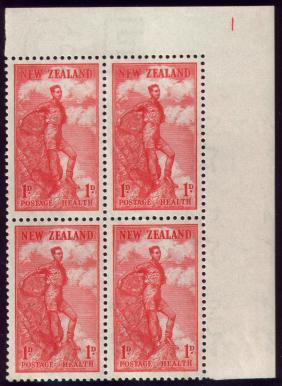
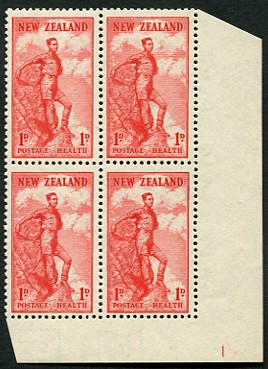
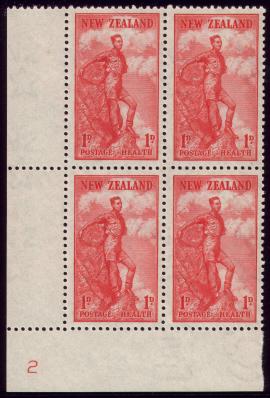
Dates:
- 1937 issued Oct 1, withdrawn 15 Feb 1938
Number sold:
- 1937: 897,035
The number sold was significantly down on the 1936 total of 1,449,980. The Health stamps for 1937-45 were demonetized on 1 December 1949.
1937 First Day Covers
There was a big expansion in the number of local health camps in 1937. Although no souvenir first day cover was produced by the Post Office, a large number of different covers were produced privately.
A major innovation was that the King George V Memorial Fund was providing the capital expenditure for the establishment of permanent health camps although it would be 1941 before the first of these opened.
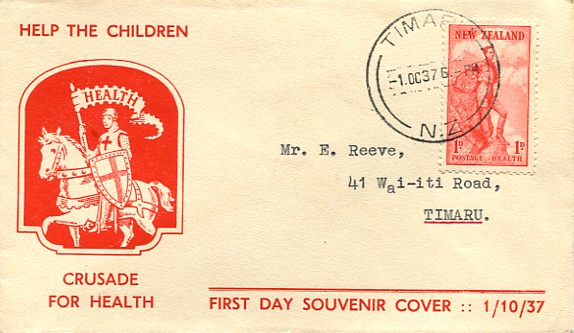
Crusader
This cover is postmarked in Timaru on 1 October 1937, the first day of issue, and shows a crusader similar to that depicted on the 1934 Health stamp.
The date of issue of the health stamp is incorporated in the cover's design, showing that the date of issue was announced at
least several days in advance.
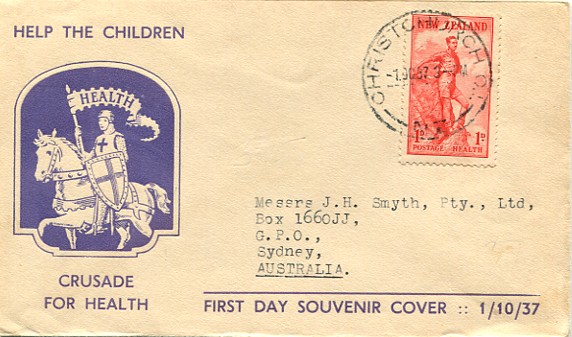
This cover is postmarked in Christchurch on 1 October 1937, the first day of issue, and is addressed to Australia.
It again shows a crusader similar to that depicted on the 1934 Health stamp, but in blue while the previous cover was in red.
There is a single line above the text at the base while in the previous example the line is doubled.
According to [2], the cover in red exists with both a single and a double line, while the cover
in blue only exists with a single line.
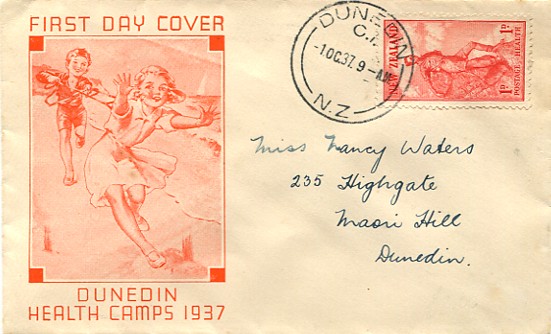
Dunedin Health Campaign
This cover is postmarked in Dunedin on 1 October 1937, the first day of issue, and addressed locally. It was produced by the Dunedin District Health Camp Committee.
The year is incorporated in the cover's design, but the date of issue is not.

Oamaru Health Campaign
This illustrated cover postmarked in Herbert (south of Oamaru) on 1 October 1937 and is addressed to Englnd. It was produced by the Oamaru Health Stamp Campaign. and followed on from the illustrated cover they had produced in 1936.
It includes the statement I've been to Kurow.
Kurow was a temporary Children's Health Camp for children from Oamaru that was set up each January in North Otago using the
Kurow racecourse buildings.
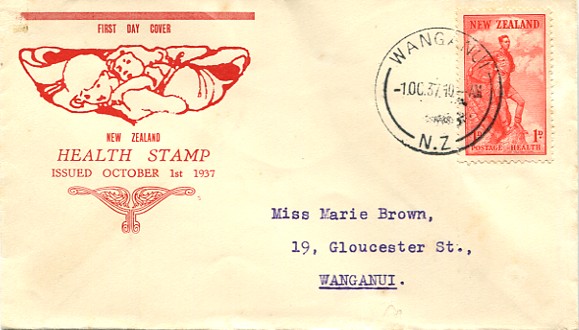
Art Deco cover postmarked in Wanganui on 1 October 1937, the first day of issue.
The date of issue of the health stamp is incorporated in the cover's design.
Similar covers in turquoise and purple also exist.
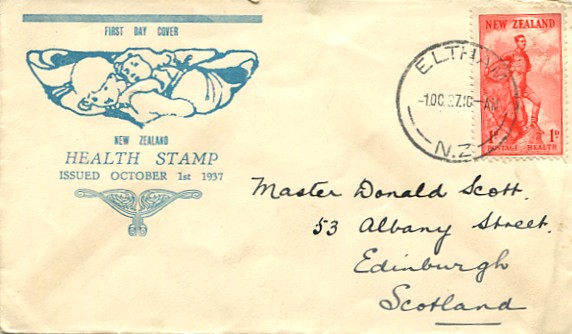
Art Deco cover postmarked in Eltham on 1 October 1937, the first day of issue and addressed to Scotland.
Similar to the previous cover, but this one is in turquoise.
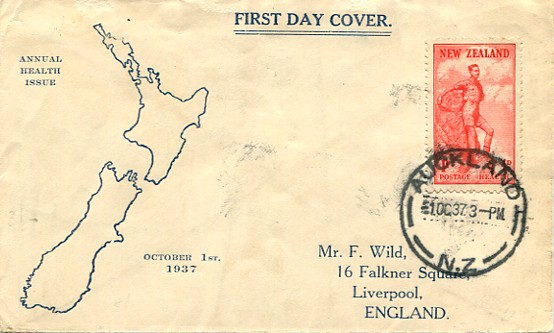
Map of New Zealand cover postmarked in Auckland on 1 October 1937, the first day of issue and addressed to Liverpool.
The map and address are printed in blue. Similar covers exist with no printed address and
also with the address printed in blue to New South Wales and to Bury St Edmunds.
Clearly this was done by the originator of the cover.

This illustrated cover postmarked in Hastings on 1 October 1937 and addressed locally.
The date of issue of the health stamp is incorporated in the cover's design.
Its slogan is Sunshine & Health.

This cover is postmarked in Waitara on 1 October 1937 and addressed locally.
The cover was produced by the Taranaki Philatelic Society and incorporates the date of issue.
Printed by McLeod & Slade, New Plymouth.
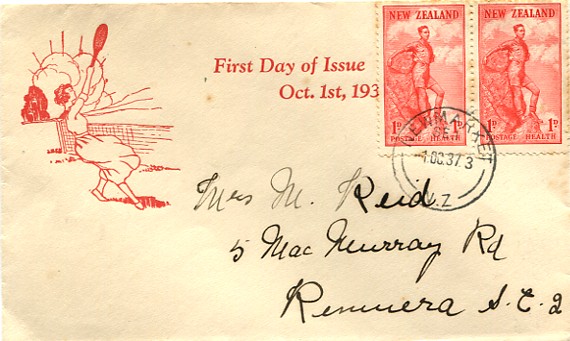
This illustrated cover showing a woman playing tennis is postmarked in Newmarket on 1 October 1937
and is addressed to Remuera.
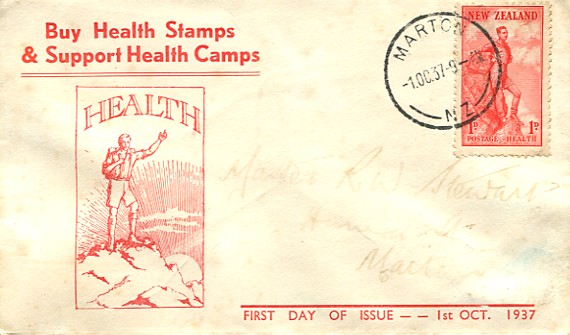
This illustrated cover showing a hiker on top of a mountain and is postmarked in Marton on 1 October 1937
and addressed locally.
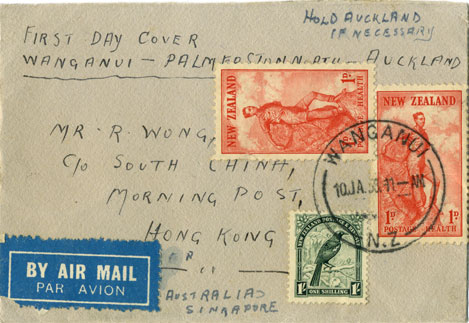
Postmarked January 1938: 1937 Health Stamp
This cover shows a pair of the 1937 Health stamps postmarked in Wanganui on 10 January 1938.
East Coast Airways extended their Gisborne - Napier service
to Wanganui on 10 January 1938.
It was sent on the first flight from Wanganui to Palmerston North and then flown to Auckland
before being sent by sea to Sydney to connect with the air mail service to Bangkok.
From Bangkok it was flown to Hong Kong.
The above information is taken from:
[1] The Postage Stamps of
New Zealand Vol 1, published by the
Royal Philatelic Society of New Zealand in 1938.
[2] Illustrated First Day Covers of New Zealand 1933-2000, Part 1: Health,
Stephen Jones, July 2008.
All scans were made by the author.